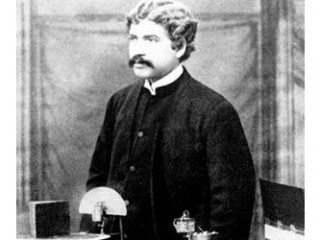
Sir Jagadish Chandra Bose, generally known as J.C. Bose, occupies a unique position in the history of modern Indian science. He is regarded as India’s first modern scientist. Jagdish Chandra Bose was an Indian physicist who pioneered the investigation of radio and microwave optics. Bose was born on November 30, 1858 in Munshiganj District in Bengal (Now situated in Bangladesh). His father Bhagwan Chandra Bose served the British India Government in various executive and magistrate of Faridpur and it is here Bose’s early childhood was mainly spent.
On May 10, 1901, the hall of the Royal Society in London was packed with eminent scientists. They were watching Jagadish Chandra Bose conduct experiments to show that plants and metals have feelings.
Among several experiments he conducted was this one: A highly sensitive instrument-one of Bose's inventions to record the "pulse" of plants-was connected to a plant. The plant, with its roots, was carefully picked up and dipped up to its stem in a vessel containing bromide, a poison. Bose looked expectantly at the light spot on a screen meant to indicate the pulse of the plant. So also did everyone else.
The plant's pulse beat, which the spot recorded as a steady to-and-fro movement like the pendulum of a clock, began to grow unsteady. Soon, the spot vibrated violently and then came to a sudden stop. It was almost like a poisoned rat breathing heavily and jerking its legs and tail its struggle against death. The plant had died because of the poison.
The experiment was greeted with thunderous applause. However, some physiologists, who steady the processes that like place inside a living organism, were not happy. Not only was Bose, a physicist, an intruder into their field, but he had, by his experiments, upset the well-known theories of some eminent physiologists present there. They were critical of Bose's conclusion that "plants and metals have life". They urged the Royal Society not to publish his lecture unless he made certain changes. Bose refused to make these changes and his experiments went unnoticed for a time. He was, however, not a person to accept defeat easily. He had acquired the quality to fight against odds from his childhood.
He started his education in a vernacular school. Then he joined the St. Xavier’s School and college at Calcutta (Kalkata). He passed the Entrance examination (equivalent to school graduation) of Calcutta University in 1875. He received a B.Sc. from Calcutta University in 1879. In January 1882, Bose left London for Cambridge where he took admission in Christ’s College to study natural sciences. His decision to join the Christ’s College was influenced by the fact that his brother -in-law, Ananda Mohan Bose had earlier studied there. Ananda Mohan, who took the Mathematics Tripos in 1874, was Cambridge’s first Indian wrangler in 1884 Bose obtained a Bechelor of Arts with a second class in natural sciences tripos and in the same year he also obtained a Bechelor of Science from the University of London.After completing his education he came back to Kolkatta and was appointed professor of physical science at Presidency College, Calcutta and holds this post till 1915. In 1917 he founded Bose Research Institute and became director of the same institute at Calcutta and remained in the post until his death on November 23, 1937. Jagadish Chandra Bose was one of the pioneers of modern science in India. His research was on the properties of electro-magnetic waves.

No comments:
Post a Comment